One can’t laud Crystalis as a masterful narrative or call it True Literature That Makes Everyone Take Gamers Like Us Seriously. It lacks character arcs and underlying themes and Aristotelian unities. Yet it gets a few things right. It’s a good example of how video games of this period are Trojan Horses; we never expected any remotely interesting melodrama from a game with simple graphics and threadbare dialogue. Yet we were involved all the same as we played, and when the game spiked its plot with a little tragedy or a moment of invention, it hit surprisingly hard. And we somehow remembered this when better stories from more respected mediums fade away.
I remembered enough to round up my favorite parts of Crystalis. I won’t give away every major twist, but I wouldn’t read this if you want to go in cold. Then again, Crystalis is almost 30 years old, and there’s a statue of limitations on these things.
THE END DAY
Crystalis doesn’t beat around the bush when destroying the world. Civilization collapsed on the first day of October in 1997, which means that the human race had less than a month to play the American version of Final Fantasy VII before everything was rent asunder in a worldwide cataclysm.
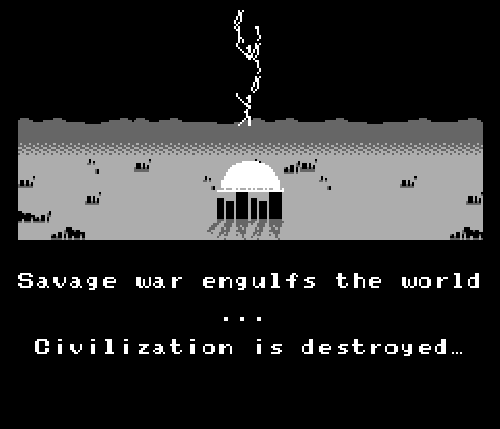
Crystalis evokes this with a few striking images for an NES game: lighting strikes, burning cities, and a huge tower floating above it all. More intriguing are the establishing shots after you push start; you’ll glimpse dragonlike beasts in a lush forest, followed by carrion birds taking flight over an arid village and the skeletal remains of a surely mutated creature.
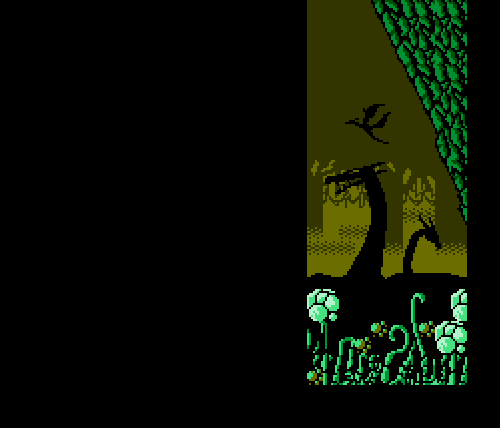
Players will note that the game itself doesn’t show anything like this in its ensuing quest. Any cutscenes are scarce until the ending. Yet that introduction is all Crystalis needs.
THE DOOMED PROSPECTOR
The second town you’ll visit in Crystalis is Brynmaer. At a bar there you can meet a young man who declares that he’s found a way to strike it rich. He then rushes out the door. Another patron reveals that the kid is off to get valuable stones from Mt. Sabre.
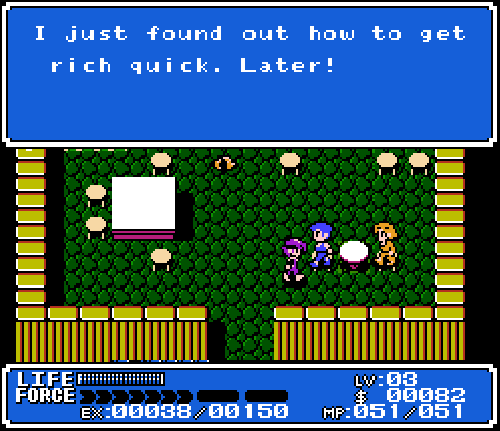
You’ll see him again soon. Mt. Sabre houses an imperial labor camp, and on his ascent the hero meets this prospector dying of his wounds not far from an inn. He utters warnings about the empire’s mine with his final breath, and then he’s gone. It’s the first of several deaths in Crystalis, and it was a rather depressing sight by the standards of video games in 1990. It’s not a valiant sacrifice. It’s not a plot device. It’s just a meaningless end.
The game even points a finger at you, the player, since this poor fellow only started off for the deadly mountain once you talked to him. If you hadn’t gone near him, would he stay at that tavern, stewing in his own avarice and ambition?
In fact, that’s the only way to save him. If you never actually speak to him, he’ll never head off to the mountain and never lie dead on the slope, even though a guest at the inn will still mention that “a guy from Brynmaer left to climb the mountain.” By avoiding him entirely you’ll spare his life, even if the game doesn’t want that.
THE SLAUGHTER AT SHYRON
You’ll catch hints of a rebellion as you wander through Crystalis. Four mystic sages advise you along the way. Townsfolk speak in discontent about the Draygonian Empire. And then you’ll arrive at the village of Shyron, which draws together just about everyone who’s aided you, from the rebel leader Azteca to your rival Stom and the itinerant treasure-seeker Akahana.
We all know what happens to rebellions. The hero leaves Shyron to infiltrate the imperial capital, but once he’s inside their city, a psychic message pops up: Shyron is under attack, and “everyone is dying!”
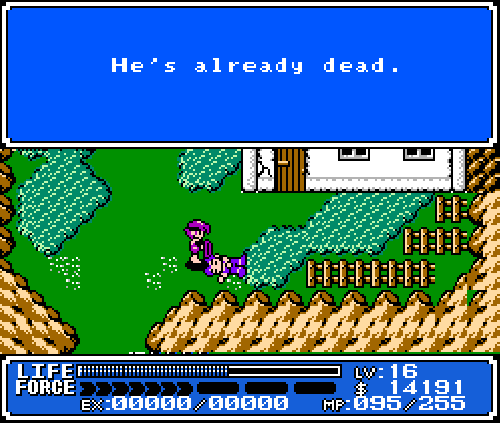
You can warp back to Shyron with magic, but you’re still too late. The empire overran the town, kidnapped the sages, and killed everyone else. Stom. Akahana. A man who told you just minutes ago of how he lost his wife and children to the empire. All dead. The hero is left to hear their final words and then face Mado, the third of the empire’s elite generals and the presumed instrument of all this carnage. This marked the first time in my life I truly hated a video game character.
DEO’S PENDANT
Not so long after Shyron falls, the hero comes upon Stom’s hometown and a herd of rabbits he looked after. Gifted now with the ability to speak to animals, the protagonist learns that one the bunnies is named Deo and that he was Stom’s favorite. What’s a hero to do? Use the Change spell to disguise yourself as Stom and talk to Deo. He’ll give you a pendant that refills your magic power automatically.
Well, it’s not that simple. At some point the creators of Crystalis realized that it was horrible of the hero to pose as this rabbit’s dead friend and con him out of some trinket. So they had the hero reveal to Deo that Stom is, in fact, dead. Deo is heartbroken but gives the protagonist the pendant and tells him to avenge Stom.
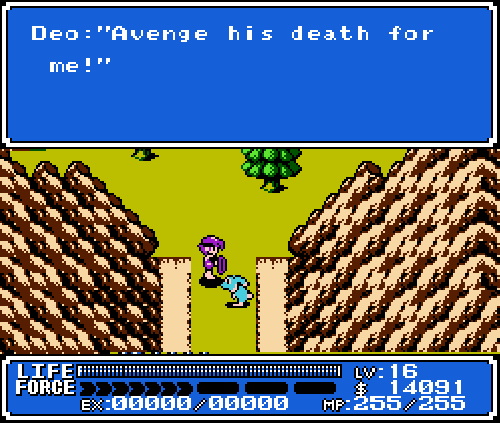
It would’ve been easy for Crystalis to play it straight and just have the player trick Deo. The game pulls a similar move when the player poses as the now-deceased Akahana to get a statue. But Crystalis draws the line at fooling a little rabbit into thinking his friend is still alive. Why? Because Crystalis cares.
THE TOWER
That enormous floating tower is a constant tease in Crystalis. It’s a fearsome weapon of ages past, created to maintain piece with the threat of its destructive power. But is it now a tool of the dark ambitions it was meant to eradicate? Or is it merely a misunderstood relic? You’ll take your time finding out, but the payoff arrives. Once the Draygonian Empire falls, the hero’s counterpart, Mesia, tells him that it’s finally time to visit the tower.
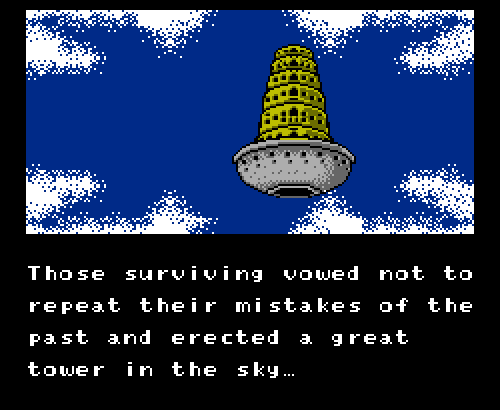
It’s a great finale. The tower looks ancient and sorcerous from the outside, a giant Babel in a salad bowl, but it’s more complex within. Guardian robots swarm you, and the decor is stonework and hieroglyphics with a high-tech cast. Crystalis sure wasn’t the first game to mix futuristic elements with fantasy–Final Fantasy had robots and nukes in 1987, after all–but it delivers that blend as the climax of a long and mystery-laced adventure.
I especially like how the first robots you’ll face are brownish, as though puttering around the tower for a century has left them coated with rust. Defeat them, and the tower will disgorge a phalanx of new mecha, silver and untarnished.
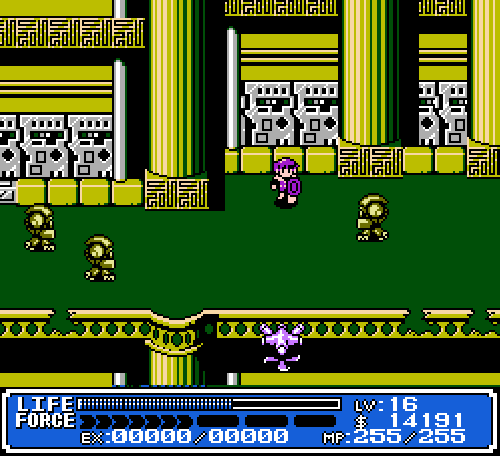
The tower also ties up everything. As you ascend, recordings disclose just who the hero, Mesia, and Azteca are and how you fit into the tower’s ultimate goal. The actual ending of Crystalis doesn’t launch any big surprises. It’s just catchy music and images of the world you saved. The real reward lies in the journey to the tower, all it reveals, and all it merely suggests.
The Game Boy Color version of Crystalis changes far too much for no good reason, even shuffling around the last two bosses apparently to make the story less satisfying. I understand one of its alterations, though: the tower is a longer, more complicated maze in the GBC version. Even at the end of the game, I wanted to see more of the tower—and Crystalis in general.

I doubt this was the developer’s intention, but I always had my own head cannon as to why you never encounter those dragon beasts in the intro. They appear to be eating plants, which makes me think they’re herbivores hence they have no reason to antagonize the protagonist. Thus you never battle any, as they’re probably just chilling out somewhere in the background of the various places you go. I figure not all the mutated creatures necessarily have to be hostile.
ReplyDeleteThat’s a good point, and the way they’re animated makes them look more like grazing dinosaurs. I guess I was disappointed that they weren’t in the background at any point in the game, but Crystalis is already pushing the NES pretty hard and the developers couldn’t bother with dino-dragons just for scenery.
ReplyDelete